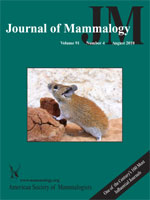This study assessed the occurrence of sexual size dimorphism (SSD) and sexual shape dimorphism (SShD) in the skull and mandible of representatives of most species within the 3 orders of living New World opossums, Didelphimorphia, Paucituberculata, and Microbiotheria, using geometric morphometrics. Centroid sizes and partial warps were extracted from landmarks set on images of the dorsal, ventral, and lateral views of the skull and lateral view of the mandible, and were compared between sexes to estimate SSD and SShD. Specimens totaling 2,932 from 71 species of Didelphidae, 5 species of Caenolestidae, and 1 species of Microbiotheriidae were analyzed. SSD was variable in the Didelphimorphia and the Paucituberculata and absent in Microbiotheria. Similar results were found for SShD, but SSD and SShD are not clearly coupled. I also evaluated the validity of Rensch's rule—the widely observed phenomenon of correlated increases in SSD and body size for male-biased sexual dimorphism, or correlated decreases in SSD in body size for female-biased sexual dimorphism—in the Didelphidae. Didelphids span 2 orders of magnitude in body size, and, when present, sexual dimorphism is male-biased. Regressions of SSD and SShD estimators onto size, using phylogenetic independent contrasts, showed either no significant relationship between SSD or SShD with size in any of the structures and views analyzed, or a trend contrary to Rensch's rule (smaller species more dimorphic, but with male-biased dimorphism). Lack of adherence to Rensch's rule in Didelphimorphia may relate to a lack of social interactions and male territoriality, usually associated with such a trend via sexual selection. If the trend contrary to Rensch's rule is real, an explanation may lie in the increasing amount of small-bodied species that recently have been found to be semelparous and thus subject to stronger selection for larger males.
How to translate text using browser tools
16 August 2010
Cranial sexual dimorphism in New World marsupials and a test of Rensch's rule in Didelphidae
Diego Astúa
ACCESS THE FULL ARTICLE

Journal of Mammalogy
Vol. 91 • No. 4
August 2010
Vol. 91 • No. 4
August 2010
Caenolestidae
Didelphidae
Microbiotheriidae
Rensch's rule
sexual shape dimorphism
sexual size dimorphism




